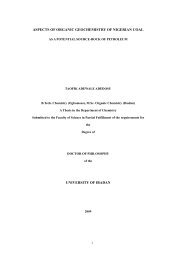- Page 2 and 3: Prof. L MakhubuPresidentTWOWSTriest
- Page 4 and 5: DOSIMETRIC TECHNIQUES FOR MAMMOGRAP
- Page 6 and 7: ABSTRACTScreening of asymptomatic w
- Page 8 and 9: materials. In current practice diam
- Page 10 and 11: ACKNOWLEDGEMENTSI would like to ren
- Page 12 and 13: CONTENTTitle page .Declaration.....
- Page 14 and 15: Chapter 1GENERAL INTRODUCTION
- Page 16 and 17: (Siemens, 2004). In the screening p
- Page 20 and 21: target produces characteristic X-ra
- Page 22 and 23: while maximizing the focal spot-to-
- Page 24 and 25: et al. (1996) concluded that for al
- Page 26 and 27: An accurate knowledge of the output
- Page 28 and 29: determine the dose (K,) to the entr
- Page 30 and 31: equation (Tucker et aI., 1991) in o
- Page 32 and 33: simulates the experimental setup an
- Page 34: REFERENCESAdam W. et al. (RD42 Coll
- Page 37 and 38: GLOBOCAN (2000). Cancer incidence,
- Page 39 and 40: Plankskoy B. (1980). Evaluation ofd
- Page 42 and 43: Chapter 2COMPARISON OF MAMMOGRAPHYR
- Page 44 and 45: ut this accounts for less than 1% o
- Page 46 and 47: calculated (Calicchia et al., 1996)
- Page 48 and 49: current-exposure time product (tube
- Page 50 and 51: 2.2.6. Contrast measurementsFilm co
- Page 52 and 53: values using a factor 0.873 (Wolbar
- Page 54 and 55: Table 2.1: The HVL values of the ma
- Page 56 and 57: Table 2.2: Comparison of ESAK and M
- Page 58 and 59: without collimation (Figures 2.4 an
- Page 60 and 61: 100 r"--------------;:====:=:;__,I:
- Page 62 and 63: 0.45[_20rnnPMMA--G-30mnPMMAO'i _40r
- Page 64 and 65: 2.5. CONCLUSIONThe study has shown
- Page 66 and 67: Dance D. R., Skinner C. L., and Car
- Page 68 and 69:
Wu X., Barnes G.T., and Tucker D.M.
- Page 70 and 71:
ELSEVIERAvailable online at www.sci
- Page 72 and 73:
Chapter 3SEGMENTED MULTIFIT OF POLY
- Page 74 and 75:
2 M Assiamah et al. I Radiation Phy
- Page 76 and 77:
4.,.,M. Assiamah et af. I Radiation
- Page 78 and 79:
6 M Assiamah et al. I Radiation Phy
- Page 80 and 81:
PERGAMONAvailable online at www.sci
- Page 82 and 83:
M Assiamah et al: I Radiation Physi
- Page 84 and 85:
M. Assiamah e! aJ. J Radiation Phys
- Page 86 and 87:
aorEi!lM. Assiamah et al. I Radiati
- Page 88 and 89:
M Assiamah et a/. I Radiation Physi
- Page 90 and 91:
At. Assiamah et al. I Radiation Phy
- Page 92 and 93:
At. Assiamah et al. I Radiation Phy
- Page 94 and 95:
Chapter 5SYNTHETIC DIAMOND AS A RAD
- Page 96 and 97:
The mass density ofdiamond is 3.515
- Page 98 and 99:
5.2. Selection ofexposnre geometry
- Page 100 and 101:
absorption levels of both exposure
- Page 102 and 103:
evolutions per minute. The polished
- Page 104 and 105:
just over 1 micron. In the measurem
- Page 106 and 107:
characterized by the quantum number
- Page 108 and 109:
(200 A)/gold (2000 A), in an ultra
- Page 110 and 111:
5.7.1. Selection of polarizing volt
- Page 112 and 113:
~:j12010080/~"~s 60"-0~: "402040 80
- Page 114 and 115:
6055•"~-e,5045&40~0iFc 35'"3025
- Page 116 and 117:
180160140120F:j 100F40200 0 30~00 "
- Page 118 and 119:
180160140120~~100~~~c 80a 0.Beforea
- Page 120 and 121:
22020000180 0 00160oi~ 140"~~ 120~"
- Page 122 and 123:
No. Descrintion Material No. Descri
- Page 124 and 125:
Figure 5.21 : Photograph of Mark UA
- Page 126 and 127:
examination reduces radiation dose
- Page 128 and 129:
Lightowlers E.C. and Dean P.J. (196
- Page 130 and 131:
Chapter 6COMPARATIVE STUDIES OF MEA
- Page 132 and 133:
(Briesmeister, 1993) and PENELOPE (
- Page 134 and 135:
density functions and thus on the c
- Page 136 and 137:
6.4.1 Geometry definition fileSimul
- Page 138 and 139:
construction of the probe was suppl
- Page 140 and 141:
The parameters Nabs, Na and N] are
- Page 142 and 143:
Table 6.1: Comparison oftotal depos
- Page 144 and 145:
6.5.1.3. Edge-on geometry versus fl
- Page 146 and 147:
Table 6.4: Comparison oftotal depos
- Page 148 and 149:
The results ofthe calculations have
- Page 150 and 151:
shows a 2D display of the geometry
- Page 152 and 153:
occurred, resulting in reduced numb
- Page 154 and 155:
Table 6.8: Calculated deposited ene
- Page 156 and 157:
Table 6.10: Calculated deposited en
- Page 158 and 159:
Table 6.12: Calculated deposited en
- Page 160 and 161:
Suggested furthermore is a method w
- Page 162 and 163:
~ "" 0 0-~"~" ;>.~1.2• Measured1.
- Page 164 and 165:
Briesmeister J.F. (1993). MNCP- A g
- Page 166 and 167:
Sempau J., Acosta E., Baro 1., Fema
- Page 168 and 169:
Radiation doses from mammography X-
- Page 170 and 171:
Radiation dose from mammography X-r
- Page 172 and 173:
their influences. An alternative me
- Page 174 and 175:
Appendix 1APPLIED UNCERTAINTIES IN
- Page 176 and 177:
ii) Tube loading (mAs) meter accura
- Page 178 and 179:
Name:Type:Dimension:Mass:Thickness:
- Page 180:
42"" Congress and Winter School oft




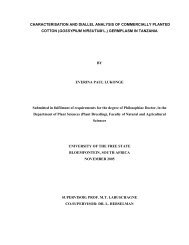


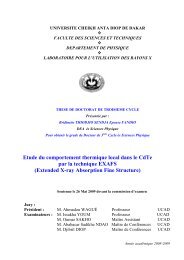
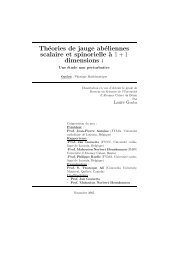

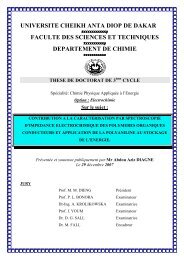
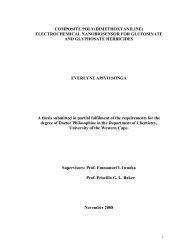


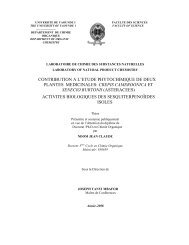
![SYNTHESIS AND ANTI-HIV ACTIVITY OF [d4U]-SPACER-[HI-236 ...](https://img.yumpu.com/30883288/1/190x245/synthesis-and-anti-hiv-activity-of-d4u-spacer-hi-236-.jpg?quality=85)
